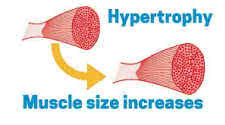No Pain No Gain for Muscle Gains - Is Pain Required for Hypertrophy

Don't Always Believe Everything your Read
About 25 years ago a writer named Dennis DuBreuil wrote about the factors that promote muscular growth. According to DuBreuil, when you train and get a good pump, fatigue products of
muscle metabolism accumulate and initiate a biochemical cascade that results in added muscle size. One notable caveat to this theory was that you had to lift heavy; just swinging
around light weights wasn't intense enough to do the job. You had to hurt to grow.
DuBreuil was so adamant about his theory that he even suggested not training another bodypart or doing aerobics for at least 20 minutes after training a muscle group. He said it took
about that long for the chemical signals to begin the process leading to an anabolic effect in muscle. DuBreuil may not have been a scientist, but according to recent research, he may
have been nothing short of visionary.
Numerous recent studies show that anischemic effect in muscle produces a significantly greater increase in muscle strength. The word ischemic refers to a limitation of blood flow and
usually describes pathological processes that affect the heart. In the new studies, however, scientists purposely decreased blood flow to working muscles by using a tourniquet mechanism.
The resulting limitation of blood flow within muscle led to accumulation of muscle metabolic substances, which, in turn, resulted in increased muscular size and strength-precisely what
DuBreuil suggested, though he never advised cutting off blood flow to muscle, believing that a pumped-up muscle would produce enough occlusion of blood flow to do the trick.
One of those muscle metabolites is lactic acid, a well-known fatigue by-product of anaerobic metabolism. In fact, the burning feeling after an intense set results from build-up of lactic
acid in muscle. When that happens, the acidity level becomes intolerable; not only does the muscle hurt, but energy enzymes needed to power continued exercise abruptly turn off as well.
When you rest between sets, the excess acid is buffered, and you can then do another set.
Lactic acid does more than act as a metabolic harbinger signaling the end of any particular set. It also appears to signal the release of growth hormone. Add it all up, and it seems that
the adage "No pain, no gain" is true. The price of added muscular size and strength is pain, and those with a high tolerance for such pain will likely make superior gains-or will they?
A new study compared two groups of 23 young, healthy adults divided into either a high-fatigue protocol (four sets of 10 reps, with 30 seconds of rest after each set) or a low-fatigue
protocol (40 reps, with 30 seconds of rest after each rep).1 The subjects trained three times a week on the leg-extension exercise, using 73 percent of their one-rep max. The high-fatigue
group's routine was designed to specifically maximize the accumulation of metabolic muscle by-products.
After 4 1/2 weeks, the high-fatigue group showed a 50 percent greater increase in isometric muscle strength, but by the nine-week mark both groups showed similar gains in muscle strength.
During the first week of training the high-fatigue group experienced severe muscle soreness indicative of muscle damage. By contrast, the low-fatigue group, though making slower-but
steady-strength gains, did not experience such muscle pain. Since both groups wound up making similar gains by the end of the study, the authors suggest that making significant muscle gains
does not require pain.
Does that mean you can now abandon heavy weights and just coast to muscle gains by using lighter weights and higher reps? Not necessarily. One problem with the study is that while the subjects
are described as "recreationally active," none had regularly lifted weights. Most initial strength gains result from changes in neuromuscular function rather than any actual changes in muscle
mass. Thus, using just about any type of training would likely lead to similar gains at the beginning. For continued gains, however, you cannot ignore the long-held overload principle of
weight training: You must in some way increase the level of resistance on a muscle.